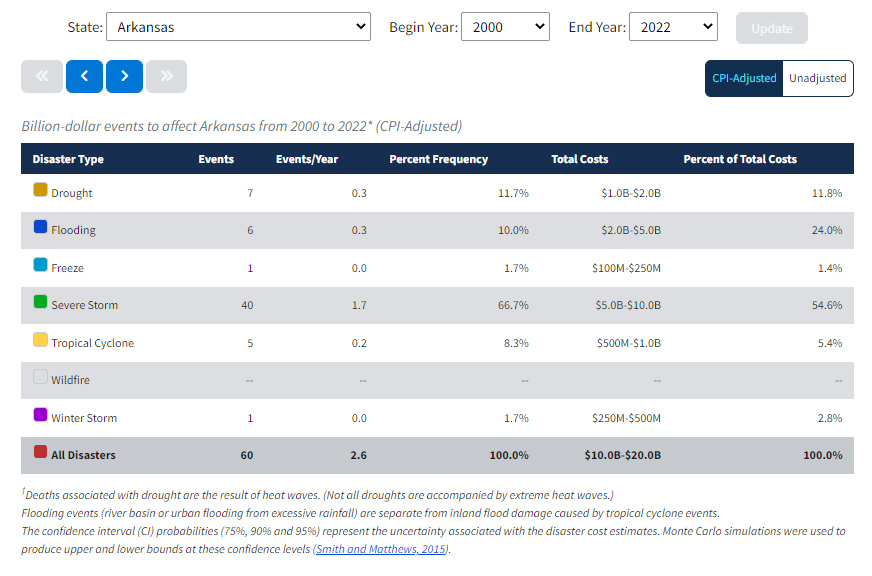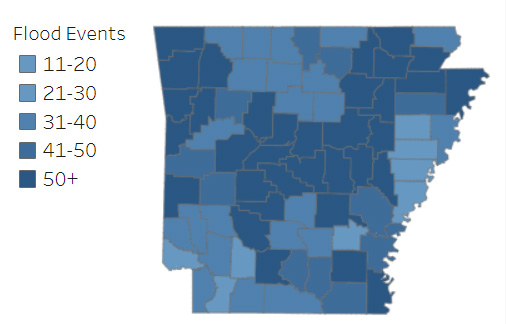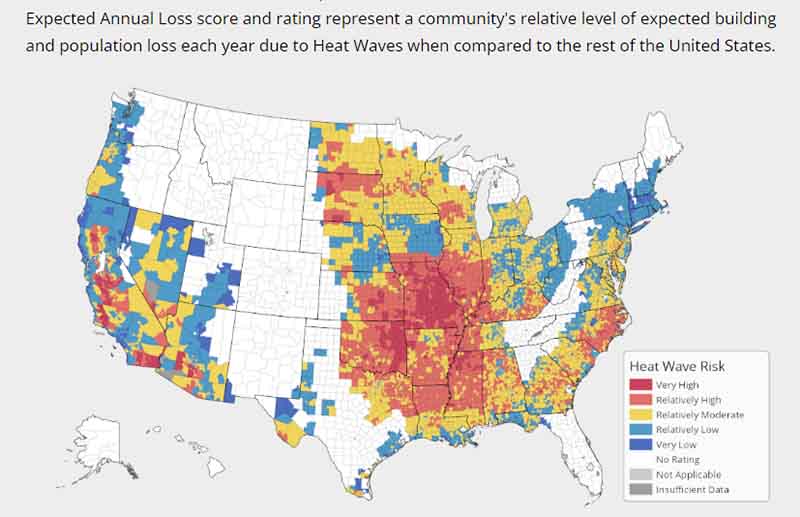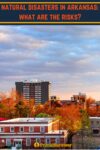Over 3 million people live in Arkansas. Many of these people have experienced natural disasters in the state firsthand. However, many don’t realize just how many different natural disasters can occur in the state or how the risk for some disasters is increasing.
Here we will go over what natural disasters occur in Arkansas, the worst natural disasters to hit the state since 2000, and what can be done to prepare.
Is Arkansas At Risk of Natural Disasters?
Arkansas has a low risk of natural disasters compared to the rest of the country. There have been 39 disaster declarations in Arkansas since 2000. Of these, 34 were Major Disaster Declarations. There were 60 disaster events affecting Arkansas, which caused more than $1 billion in damages.
Since 2000 in Arkansas, there have been:
- 39 disaster declarations
- 34 Major Disaster Declarations
- 60 events that caused $1 billion or more in damages

Worst Natural Disasters in Arkansas Since 2000
Since 2000, hurricanes have been the worst natural disasters in Arkansas. The costliest ones were hurricanes Ida, Ike, and Rita. In addition to hurricanes, tornadoes, drought, and winter storms have been particularly destructive in Arkansas.
*Cost and death tolls are for the entire disaster, including in other states affected.
Worst Natural Disasters in Alabama By Cost (Since 2000)
- Hurricane Ida 2021: $78.7 billion
- Hurricane Ike 2008: $40.2 billion
- 2012 drought and heat wave: $38.7 billion
- Hurricane Rita 2005: $27.2 billion
- Hurricane Laura 2020: $26 billion
Worst Natural Disasters in Alabama By Deaths (Since 2000)
- April 2011 tornado outbreak: 321 deaths
- Feb 2021 winter storm: 262 deaths
- May 2011 tornado outbreak: 177 deaths
- 2000 drought and heat wave: 140 deaths
- 2012 drought and heat wave: 123 deaths
Most Common Natural Disasters in Arkansas
1. Tornadoes
Severe storms, including tornado outbreaks, are Arkansas’s most common natural disaster. Forty separate $1-billion severe storms have hit the state since 2000. Severe storms are the most common reason the state must declare an emergency.
In addition to these major tornadoes, Arkansas also regularly gets smaller ones. On average, Arkansas gets 37 tornadoes each year.
Because of this, Arkansans must be prepared for tornadoes.
Read:
- How to Build Your Own Tornado Shelter on a Budget
- Best Underground Tornado Shelters
- Best Aboveground Tornado Shelters
Worst Tornadoes in Arkansas in Recent History:
The April 2011 tornado outbreak is the largest and costliest tornado disaster in history. The outbreak consisted of over 360 tornadoes in many central and southern states. In total, 321 people died from the outbreak. Arkansas wasn’t as severely affected as other states, but the cost was still over $3 million.
Just one month later, another massive tornado outbreak occurred. This one caused $11.7 billion in damages and 177 deaths.
2. Severe Storms
In addition to tornadoes, Arkansas also regularly has severe storms. In 2021 alone, there were 36 days with heavy rain, lightning, or strong winds. While these generally do not merit a disaster declaration, the storms can still cause massive property damage.
Arkansas is one of the top 10 states for lightning activity and averages more than 830,000 cloud-to-ground lightning flashes yearly. Because of this, it is no surprise that Arkansas is also one of the top states for lightning fatalities and injuries.
3. Floods
Since 2000, Arkansas has experienced 6 floods that caused $1 billion or more in damages. The year 2019 was particularly bad for flooding in Arkansas. Both the Mississippi and Arkansas Rivers flooded, causing more than $10 billion in damages.
Arkansas also regularly experiences smaller flood events. As shown in the image, every county in Arkansas has been hit by floods multiple times since 1980.
Heavy rains in Arkansas can also result in flash floods. One of the most devastating ones was the Albert Pike Flash Floods in June 2010. The flood swept through a campsite and killed 20 people.
Read: How to Prepare for Flooding

4. Droughts and Heat Waves
Arkansas is one of the most at-risk states regarding heat waves. The state has an average of 15-30 days per year with temperatures above 95F. These temperatures can also reach over 100 degrees F and stay high for multiple days.
These heat waves can be deadly to vulnerable populations. In 2021 alone, the state had 54 deaths due to heat-related illnesses.
Major heat waves in Arkansas can also bring drought, which destroys crops. Since agriculture is the state’s most significant industry, drought also takes a substantial economic toll in Arkansas.
Heat waves are expected to get much worse in Arkansas. Within 70 years, the number of days with temperatures above 95F will likely increase to 30-60 days.
Also Read: Prepare for a Heat Wave

5. Wildfires
Heat waves and drought in Arkansas cause dry conditions, which can lead to wildfire outbreaks. The wildfires can occur at any time during the year and regularly burn thousands of acres. The good news is that Arkansas has gotten better at containing wildfires. In the past two decades, there has been a drop in the number of wildfires and acres burned.
Despite this, Arkansans should still be prepared for wildfires. This includes having a family bug out bag packed, a bug-out plan, and keeping vital documents in a fireproof safe.
6. Winter Storms and Freeze Events
Arkansas has a humid subtropical climate and generally has mild weather. However, this does not mean that Arkansas isn’t at risk of severe winter weather. Since 2000, Arkansas has declared disaster 6 times due to severe winter and ice storms.
The ice storm which hit in December of 2000 was the worst in the state’s history. Over 600,000 people lost power, many of whom did not get it back for weeks.
Arkansas also had a severe winter in 2021. Parts of the state had temperatures drop to -20F, an all-time record. In addition to causing road accidents, the extreme weather hurts Arkansas’s farming economy. For example, many calves die during winter storms.
To be prepared, Arkansas residents should have winter emergency items in their vehicles, supplies for hunkering down, and an emergency indoor heater that doesn’t require electricity.
7. Hurricanes/Tropical Storms
Even though Arkansas isn’t a coastal state, hurricanes still affect it. Since 2000, the state has declared disaster three times because of hurricanes: in 2020 for Hurricane Laura, 2008 for Hurricane Gustav, and 2005 for Hurricane Katrina.
The state has also been affected by numerous $1-billion hurricanes, though the damage is usually more severe in nearby coastal states such as Louisiana.
Read: How to Survive a Hurricane
8. Earthquakes
Arkansas is located near the New Madrid Seismic Zone. Because of this, the state regularly experiences earthquakes. There are an average of 200 earthquakes in this zone per year. However, most of these earthquakes are too small to notice and don’t cause any damage.
However, if a magnitude 7.6 earthquake were to occur, it would cause significant damage to the northeastern parts of Arkansas.
It is impossible to predict if and when an earthquake will occur, so Arkansans need to be prepared. This includes making sure to have an earthquake kit, knowing how to shut off utilities, and a Go Bag packed in case you need to evacuate your home.
Also read: How to Prepare for an Earthquake
https://www.agriculture.arkansas.gov/forestry/wildfire-statistics/
https://www.kark.com/weather/weather-headlines/endless-100s-arkansas-to-see-the-hottest-stretch-in-a-decade/
https://www.publicnewsservice.org/2022-06-17/climate-change-air-quality/soaring-temperatures-in-ar-pose-potential-for-heat-related-illnesses/a79529-2
https://www.arkansasonline.com/news/2021/mar/08/experts-extreme-weather-growing-more-common/
https://www.usgs.gov/centers/kansas-water-science-center/historic-floods-along-arkansas-river
https://www.fema.gov/data-visualization/historical-flood-risk-and-costs
https://www.geology.arkansas.gov/geohazards/earthquakes-in-arkansas.html
https://dnr.mo.gov/land-geology/hazards/earthquakes/science/facts-new-madrid-seismic-zone
https://dnr.mo.gov/land-geology/hazards/earthquakes/science/facts-new-madrid-seismic-zone
https://www.fema.gov/disaster/declarations
https://www.ncei.noaa.gov/access/billions/events/


